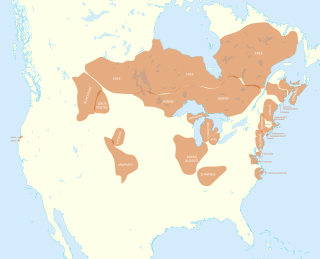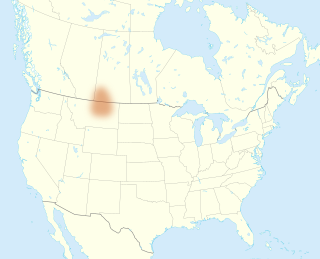
The Algonquian languages are a subfamily of the Indigenous languages of the Americas and most of the languages in the Algic language family are included in the group. The name of the Algonquian language family is distinguished from the orthographically similar Algonquin dialect of the Indigenous Ojibwe language (Chippewa), which is a senior member of the Algonquian language family. The term Algonquin has been suggested to derive from the Maliseet word elakómkwik, "they are our relatives/allies".

The Arapaho are a Native American people historically living on the plains of Colorado and Wyoming. They were close allies of the Cheyenne tribe and loosely aligned with the Lakota and Dakota.

Quiripi was an Algonquian language formerly spoken by the indigenous people of southwestern Connecticut and central Long Island, including the Quinnipiac, Unquachog, Mattabessett (Wangunk), Podunk, Tunxis, and Paugussett. It has been effectively extinct since the end of the 19th century, although Frank T. Siebert, Jr., was able to record a few Unquachog words from an elderly woman in 1932.

The Algic languages are an indigenous language family of North America. Most Algic languages belong to the Algonquian subfamily, dispersed over a broad area from the Rocky Mountains to Atlantic Canada. The other Algic languages are the Yurok and Wiyot of northwestern California, which, despite their geographic proximity, are not closely related. All these languages descend from Proto-Algic, a second-order proto-language estimated to have been spoken about 7,000 years ago and reconstructed using the reconstructed Proto-Algonquian language and the Wiyot and Yurok languages.

The Delaware languages, also known as the Lenape languages, are Munsee and Unami, two closely related languages of the Eastern Algonquian subgroup of the Algonquian language family. Munsee and Unami were spoken aboriginally by the Lenape people in the vicinity of the modern New York City area in the United States, including western Long Island, Manhattan Island, Staten Island, as well as adjacent areas on the mainland: southeastern New York State, eastern Pennsylvania, New Jersey, Connecticut, Maryland, and Delaware.

Plateau Penutian is a family of languages spoken in northern California, reaching through central-western Oregon to northern Washington and central-northern Idaho.

The Gros Ventre, also known as the A'aninin, Atsina, or White Clay, are a historically Algonquian-speaking Native American tribe located in northcentral Montana. Today, the Gros Ventre people are enrolled in the Fort Belknap Indian Community of the Fort Belknap Reservation of Montana, a federally recognized tribe with 7,000 members, also including the Assiniboine people.
The Arapaho (Arapahoe) language is one of the Plains Algonquian languages, closely related to Gros Ventre and other Arapahoan languages. It is spoken by the Arapaho of Wyoming and Oklahoma. Speakers of Arapaho primarily live on the Wind River Indian Reservation in Wyoming, though some have affiliation with the Cheyenne living in western Oklahoma.

Kalapuyan is a small extinct language family that was spoken in the Willamette Valley of Western Oregon, United States. It consists of three languages.

Munsee is an endangered language of the Eastern Algonquian subgroup of the Algonquian language family, itself a branch of the Algic language family. Munsee is one of two Delaware languages. It is very closely related to the Unami Delaware, but the two are sufficiently different that they are considered separate languages. Munsee was spoken aboriginally by Lenape in the vicinity of the modern New York City area in the United States, including western Long Island, Manhattan Island, Staten Island, as well as adjacent areas on the mainland: southeastern New York State, the northern third of New Jersey, and northeastern Pennsylvania.
Robert Hale Ives Goddard III is a linguist and a curator emeritus in the Department of Anthropology of the National Museum of Natural History at the Smithsonian Institution. He is widely considered the leading expert on the Algonquian languages and the larger Algic language family.
Proto-Algonquian is the proto-language from which the various Algonquian languages are descended. It is generally estimated to have been spoken around 2,500 to 3,000 years ago, but there is less agreement on where it was spoken. The Algonquian family, which is a branch of the larger Algic language family, is usually divided into three subgroups: Eastern Algonquian, which is a genetic subgroup, and Central Algonquian and Plains Algonquian, both of which are areal groupings. In the historical linguistics of North America, Proto-Algonquian is one of the best studied, most thoroughly reconstructed proto-languages. It is descended from Proto-Algic.

The Eastern Algonquian languages constitute a subgroup of the Algonquian languages. Prior to European contact, Eastern Algonquian consisted of at least 17 languages, whose speakers collectively occupied the Atlantic coast of North America and adjacent inland areas, from what are now the Maritimes of Canada to North Carolina. The available information about individual languages varies widely. Some are known only from one or two documents containing words and phrases collected by missionaries, explorers or settlers, and some documents contain fragmentary evidence about more than one language or dialect. Many of the Eastern Algonquian languages were greatly affected by colonization and dispossession. Miꞌkmaq and Malecite-Passamaquoddy have appreciable numbers of speakers, but Western Abenaki and Lenape (Delaware) are each reported to have fewer than 10 speakers after 2000.
The Central Algonquian languages are commonly grouped together as a subgroup of the larger Algonquian family, itself a member of the Algic family. Though the grouping is often encountered in the literature, it is an areal grouping, not a genetic grouping. In other words, the languages are grouped together because they were spoken near one another, not because they are more closely related to one another than to other Algonquian languages. Within the Algonquian family, only Eastern Algonquian is a valid genealogical group.
Mohican is a language of the Eastern Algonquian subgroup of the Algonquian language family, itself a member of the Algic language family. It was spoken in the territory of present-day eastern New York state and Vermont by the Mohican people but is believed to have been extinct since the 1930s. However, since the late 2010s, the language is being revived, with adults learning the language, and children being raised having Mohican as their first language.
The Arapahoan languages are a subgroup of the Plains group of Algonquian languages: Nawathinehena, Arapaho, and Gros Ventre.

Atsina, or Gros Ventre, was the ancestral language of the Gros Ventre people of what is today Montana, United States of America. The last fluent speaker died in 2007, though revitalization efforts are underway.
Nawathinehena is an extinct Algonquian language formerly spoken among the Arapaho. It had a phonological development quite different from either Gros Ventre or Arapaho proper. It has been identified as the former language of the Southern Arapaho, who switched to speaking Arapaho proper in the 19th century. However, the language is not well attested, being documented only in a vocabulary collected in 1899 by Alfred L. Kroeber from the Oklahoma Arapaho.
Truman Michelson was a linguist and anthropologist who worked from 1910 until his death for the Bureau of American Ethnology at the Smithsonian Institution. He also held a position as ethnologist at George Washington University from 1917 until 1932.
Proto-Algonquian is one of the best-reconstructed proto-languages of the Americas. As it broke up, its daughters, such as Cree, Menominee, Ojibwe and Arapaho, changed the original phonology of Proto-Algonquian and gave rise to new languages. Notable changes include the merger of *θ and *r in most descendant languages, the merger of short *i and *e in Cree and Ojibwe, the far-reaching and unexpected sound shifts of Plains Algonquian languages, and the simplification of original clusters in the Algonquian languages.










